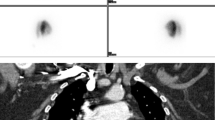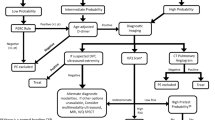Abstract
Pulmonary embolism remains a challenging diagnostic problem. We developed a simple diagnostic strategy based on combination of assessment of the pretest probability with perfusion lung scan results to reduce the need for pulmonary angiography. We studied 390 consecutive patients (78% in-patients) with suspected pulmonary embolism. The pretest probability was rated low (<10%), intermediate (>10%, ≤50%), moderately high (>50%, ≤90%) or high (>90%) according to a structured clinical model. Perfusion lung scans were independently assigned to one of four categories: normal; near-normal; abnormal, suggestive of pulmonary embolism (wedge-shaped perfusion defects); abnormal, not suggestive of pulmonary embolism (perfusion defects other than wedge shaped). Pulmonary embolism was diagnosed in patients with abnormal scans suggestive of pulmonary embolism and moderately high or high pretest probability. Patients with normal or near-normal scans and those with abnormal scans not suggestive of pulmonary embolism and low pretest probability were deemed not to have pulmonary embolism. All other patients were allocated to pulmonary angiography. Patients in whom pulmonary embolism was excluded were left untreated. All patients were followed up for 1 year. Pulmonary embolism was diagnosed non-invasively in 132 patients (34%), and excluded in 191 (49%). Pulmonary angiography was required in 67 patients (17%). The prevalence of pulmonary embolism was 41% (n=160). Patients in whom pulmonary embolism was excluded had a thrombo-embolic risk of 0.4% (95% confidence interval: 0.0%–2.8%). Our strategy permitted a non-invasive diagnosis or exclusion of pulmonary embolism in 83% of the cases (95% confidence interval: 79%–86%), and appeared to be safe.




Similar content being viewed by others
References
Silverstein MD, Heit JA, Mohr DN, et al. Trends in the incidence of deep vein thrombosis and pulmonary embolism. A 25-year population-based study. Arch Intern Med 1998; 158:585–593.
Heit JA, Silverstein MD, Mohr DN, et al. Predictors of survival after deep vein thrombosis and pulmonary embolism. A population-based cohort study. Arch Intern Med 1999; 159:445–453.
PIOPED Investigators. Value of the ventilation-perfusion scan in acute pulmonary embolism: results of the Prospective Investigation of Pulmonary Embolism Diagnosis (PIOPED). JAMA 1990; 263:2753–2759.
Hull RD, Raskob GE, Ginsberg JS, et al. A nonivasive strategy for the treatment of patients with suspected pulmonary embolism. Arch Intern Med 1994; 154:289–297.
Wells PS, Ginsberg JS, Anderson DR, et al. Use of a clinical model for safe management of patients with suspected pulmonary embolism. Ann Intern Med 1998; 129:995–1005.
Perrier A, Desmarais S, Goehring C, et al. D-dimer testing for suspected pulmonary embolism in outpatients. Am J Respir Crit Care Med 1997; 156:492–496.
Ginsberg JS, Well PS, Kearon C, et al. Sensitivity and specificity of a rapid whole-blood assay for D-dimer in the diagnosis of pulmonary embolism. Ann Intern Med 1998; 129:1006–1011.
Wells PS, Anderson DR, Rodger M, et al. Excluding pulmonary embolism at the bedside without diagnostic imaging: management of patients with suspected pulmonary embolism presenting to the emergency department by using a simple clinical model and D-dimer. Ann Intern Med 2001; 135:98–107.
Perrier A, Desmarais S, Miron MJ et al. Non-invasive diagnosis of venous thromboembolism in outpatients. Lancet 1999; 353:190–195.
Miniati M, Pistolesi M, Marini C, et al. Value of perfusion lung scan in the diagnosis of pulmonary embolism: results of the Prospective Investigative Study of Acute Pulmonary Embolism Diagnosis (PISA-PED). Am J Respir Crit Care Med 1996; 154:1387–1393.
Miniati M, Prediletto R, Formichi B, et al. Accuracy of clinical assessment in the diagnosis of pulmonary embolism. Am J Respir Crit Care Med 1999; 159:864–871.
Miniati M, Monti S, Bottai M. A structured clinical model for predicting the probability of pulmonary embolism. Am J Med 2003; 114:173–179.
Kipper MS, Moser KH, Kortman KE, Ashburn WL. Long term follow-up of patients with suspected pulmonary embolism and a normal lung scan. Chest 1982; 82:411–415.
Hull RD, Raskob GE, Coates G, Panju AA. Clinical validity of a normal perfusion scan in patients with suspected pulmonary embolism. Chest 1990; 97:23–26.
van Beek EJR, Kuijer PMM, Schenk BE, et al. A normal perfusion lung scan in patients with clinically suspected pulmonary embolism: frequency and clinical validity. Chest 1995; 108:170–173.
Meyer G, Collignon MA, Guinet F, et al. Comparison of perfusion lung scanning and angiography in the estimation of vascular obstruction in acute pulmonary embolism. Eur J Nucl Med 1990; 17:315–319.
Fleiss JL. Measuring nominal scale agreement among many raters. Psycol Bull 1971; 76:378–382.
Fleiss JL, Cohen LJ, Everitt BS. Large sample standard errors of kappa and weighted kappa. Psycol Bull 1969; 72:323–327.
Gilday DL, Poulose KP, De Land FH. Accuracy of detection of pulmonary embolism by lung scanning correlated with pulmonary angiography. Am J Roentgenol Radium Ther Nucl Med 1972; 115:732–738.
Moses DC, Silver TM, Bookstein JJ. The complementary roles of chest radiography, lung scanning, and selective pulmonary angiography in the diagnosis of pulmonary embolism. Circulation 1974; 49:179–188.
Lensing AWA, Prandoni P, Prins MH, Büller HR. Deep vein thrombosis. Lancet 1999; 353:479–485.
Turkstra F, Kuijer PMM, van Beek EJR, et al. Diagnostic utility of ultrasonography of leg veins in patients suspected of having pulmonary embolism. Ann Intern Med 1997; 126:775–781.
Bounameaux H, de Moerloose P, Perrier A, et al. D-dimer testing in suspected venous thromboembolism: an overview. QJM 1997; 90:437–442.
Miron MJ, Perrier A, Bounameaux H, et al. Contribution of nonivasive evaluation to the diagnosis of pulmonary embolism in hospitalized patients. Eur Respir J 1999; 13:1365–1370.
Wells, PS, Lensing AWA, Davidson BL, et al. Accuracy of ultrasound for the diagnosis of deep vein thrombosis in asymptomatic patients after orthopaedic surgery. Ann Intern Med 1995; 122:47–53.
Mullins MD, Becker DM, Hagspiel KD, Philbrick JT. The role of volumetric computed tomography in the diagnosis of pulmonary embolism. Arch Intern Med 2000; 160:293–298.
Rathbun SW, Raskob GE, Whitsett TL. Sensitivity and specificity of helical computed tomography in the diagnosis of pulmonary embolism: a systematic overview. Ann Intern Med 2000; 132:227–232.
Musset D, Parent F, Meyer G, et al. Diagnostic strategy for patients with suspected pulmonary embolism: a prospective multicentre outcome study. Lancet 2002; 360:1914–1920.
Acknowledgements
The authors wish to thank Dr. Matteo Bottai for statistical advice, and Marco Salvadori for excellent technical assistance. This work was supported in part by the Ministry of Health and the Ministry of University and Scientific and Technological Research of Italy.
Author information
Authors and Affiliations
Corresponding author
Rights and permissions
About this article
Cite this article
Miniati, M., Monti, S., Bauleo, C. et al. A diagnostic strategy for pulmonary embolism based on standardised pretest probability and perfusion lung scanning: a management study. Eur J Nucl Med Mol Imaging 30, 1450–1456 (2003). https://doi.org/10.1007/s00259-003-1253-7
Received:
Accepted:
Published:
Issue Date:
DOI: https://doi.org/10.1007/s00259-003-1253-7




